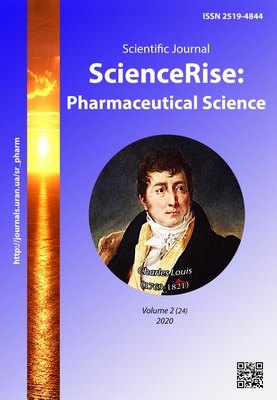Caltha palustris. Analytical overview
DOI:
https://doi.org/10.15587/2519-4852.2020.201616Keywords:
Ranunculaceae, Caltha palustris, protoanemonin, anemonin, biologically active substances, pharmacological actionAbstract
The aim. Analysis and synthesis of data on the area of growth, content of biologically active compounds and the spectrum of use in pharmacy and medicine Caltha palustris.
Materials and methods. Literary and electronic sources of information regarding the distribution, chemical composition and pharmacological activity of Caltha palustris.
Results. Caltha palustris is a perennial herb of the Ranunculaceae family. The plant is unofficial, widely used by folk medicine as an anti-inflammatory, antispasmodic, bactericidal, antimicrobial, analgesic, diuretic agent. The main biologically active substances of Caltha palustris are tannins, glycosides (γ-lactones of protoanemonin and anemonin), saponins, berberine, bitterness, vitamin C, choline, carotene, flavonoids and alkaloids. Caltha palustris is a regionally rare plant in the administrative territories of Ukraine. Given the relevance of expanding the range of medicinal plant raw materials for the creation of modern therapeutics and chemical composition, pharmacological action of Caltha palustris, it is advisable to conduct further resource, phytochemical and other studies of the plant.
Conclusions. Considering the extensive experience in folk medicine, the wide range of pharmacological activity, the content of valuable biologically active compounds Caltha palustris is a promising and valuable raw material for the preparation and production of phytochemicals and their practical applicationReferences
- Bhandari, P., Rastogi, R. P. (1984). Two nor-triterpene lactones from Caltha palustris. Phytochemistry, 23 (8), 1699–1702. doi: http://doi.org/10.1016/s0031-9422(00)83472-x
- Bhandari, P., Gray, A., Rastogi, R. (1987). Triterpenoid Saponins fromCaltha palustris. Planta Medica, 53 (1), 98–100. doi: http://doi.org/10.1055/s-2006-962634
- Bhandari, P., Rastogi, R. P. (1984). Triterpene constituents of Caltha palustris. Phytochemistry, 23 (9), 2082–2085. doi: http://doi.org/10.1016/s0031-9422(00)84984-5
- Jurgens, A., Dotterl, S. (2004). Chemical composition of anther volatiles in Ranunculaceae: genera-specific profiles in Anemone, Aquilegia, Caltha, Pulsatilla, Ranunculus, and Trollius species. American Journal of Botany, 91 (12), 1969–1980. doi: http://doi.org/10.3732/ajb.91.12.1969
- Suszko, A., Obmińska-Mrukowicz, B. (2013). Influence of polysaccharide fractions isolated from Caltha palustris L. on the cellular immune response in collagen-induced arthritis (CIA) in mice. A comparison with methotrexate. Journal of Ethnopharmacology, 145 (1), 109–117. doi: http://doi.org/10.1016/j.jep.2012.10.038
- Bruni, A., Bonora, A., Dall’Olio, G. (1986). Protoanemonin Detection in Caltha palustris. Journal of Natural Products, 49 (6), 1172–1173. doi: http://doi.org/10.1021/np50048a058
- Mubashir, S., Dar, M. Y., Lone, B. A., Zargar, M. I., Shah, W. A. (2014). Anthelmintic, antimicrobial, antioxidant and cytotoxic activity of Caltha palustris var. alba Kashmir, India. Chinese Journal of Natural Medicines, 12 (8), 567–572. doi: http://doi.org/10.1016/s1875-5364(14)60087-x
- Agnieszka, S., Bozena, O.-M. (2017). Effects of polysaccharide fractions isolated from Caltha palustris L. on the activity of phagocytic cells & humoral immune response in mice with collagen-induced arthritis: A comparison with methotrexate. Indian Journal of Medical Research, 145 (2), 229–236.
- Hrodzinskyi, A. M. (Ed.) (1989). Likarski roslyny. Kyiv: URE, 480–481.
- Ostapko, V. M. (Ed.) (2010). Chervona knyha Donetskoi oblasti: Roslynnyi svit. Donetsk: «Nova pechat», 58.
- Kaliuzhnytsia bolotna (Caltha palustris). Available at: http://fitoapteka.org/herbs-k/1073-caltha-palustris
- Kurenkova, E. M., Starodubtseva, A. M. (2018). Iadovitye rasteniia senokosov i pastbisch lesnoy zony evropeyskoy chasti Rossii: semeystvo Ranunculaceae. Kormoproizvodstvo, 6. Available at: http://kormoproizvodstvo.ru/6-2018/06-2018-03-02-1201/
- Cieślak, E., Ilnicki, T., Flis, M. (2000). Tsytotaksonomichni doslidzhennia kompleksu Caltha palustris (Ranunculaceae) u Polshchi. Poperednii zvit. Acta Biologica Cracoviensia. Series Botanica, 42 (1), 121–129.
- Didukh, Ya. P. (Ed.) (2004). Ekoflora Ukrainy. Vol. 2. Kyiv: Fitosotsiotsentr, 480.
- Нестерук, Ю. (2003). Чорногора. Львів: БаК, 122–123.
- Ukrainian Biodiversity Information Network. Available at: http://www.ukrbin.com/
- Wijnands, D. O. (1994). The double-flowered Caltha palustris. Euphytica, 73 (3), 225–239. doi: http://doi.org/10.1007/bf00036702
- Samura, B. A. (Ed.) (2003). Fitoterapiia v klinike vnutrennih bolezney. Harkov: Izd-vo NFaU: Zolotye stranitsy, 416.
- Sokolov, P. D. (1994). Rastitelnye resursy. Sankt-Peterburg: Nauka, 112.
- Orlov, B. N., Gelashvili, D. B., Ibragimov, A. K. (1990). IAdovitye zhivotnye i rasteniia SSSR. Moscow: Vysshaia shkola, 226–227.
- Martynov, A. M., Dul, V. N., Dargaeva, T. D., Chuparina, E. V. (2017). Izuchenie himicheskogo sostava travy kaluzhnitsy bolotnoy (Caltha palustris ). Voprosy obespecheniia kachestva lekarstvennyh sredstv, 4 (18), 66–71.
- Rastitelnye resursy SSSR. TSvetkovye rasteniia, ih himicheskiy sostav, ispolzovanie; Semeystva Magnoliaceae – Limoniaceae (1984). Leningrad: Nauka, 55–57.
- Kaliuzhnytsia bolotna, likarski vlastyvosti, otruinist ta protypokazannia (2019). Available at: https://toxic-plants.pp.ua/index.php/otrujni-roslini/rodyna-zhovtetsevi/606-kalyuzhnitsya-bolotna-likarski-vlastivosti-otrujnist-ta-protipokazannya
- Bonora, A., Tosi, B., Donini, A., Botta, B., Bruni, A. (1987). Elicitor-induced Accumulation of Protoanemonin in Caltha palustris L. Journal of Plant Physiology, 131 (5), 489–494. doi: http://doi.org/10.1016/s0176-1617(87)80291-2
- Entsiklopedicheskiy slovar F. A. Brokgauza i I. A. Efrona (1890–1907). Saint Petersburg: Brokgauz-Efron.
- Preobrazhenskiy, N. A., Genkin, E. I. (1953). Himiia organicheskih lekarstvennih veschestv. Moscow: Leningrad: GOSKHIMIZDAT, 595.
- Formanchuk, K. V. (Ed.) (2007). Roslyny daruiut zdorovia: Fitoterapevtychnyi entsyklopedychnyi dovidnyk. Lviv; Avers, 568.
- Pnevskyi, V. (2016). Zolotysta kaima vesny. Lisovyi visnyk, 4 (55). Available at: https://lisvisnyk.com.ua/%D0%B7%D0%BE%D0%BB%D0%BE%D1%82%D0%B8%D1%81%D1%82%D0%B0-%D0%BA%D0%B0%D0%B9%D0%BC%D0%B0-%D0%B2%D0%B5%D1%81%D0%BD%D0%B8/
- Halium-Kheel – instruktsiia, pokazannia, sklad, sposib zastosuvannia. Available at: https://tabletki.ua/uk/
- Washington HomeopathicProducts. Available at: http://www.homeopathyworks.com
- European Patent Office. Available at: https://worldwide.espacenet.com/
- Yelin, Yu. Ya., Zerova, M. Ya., Lushpa, V. I., Shabrova, S. I. (1983). Dary lisiv. Kyiv: Urozhai, 437.
Downloads
Published
How to Cite
Issue
Section
License
Copyright (c) 2020 Viktiriia Liakh, Roksolana Konechna, Andriy Mylyanych, Lesia Zhurakhivska, Iryna Hubytska, Volodymyr Novikov

This work is licensed under a Creative Commons Attribution 4.0 International License.
Our journal abides by the Creative Commons CC BY copyright rights and permissions for open access journals.








